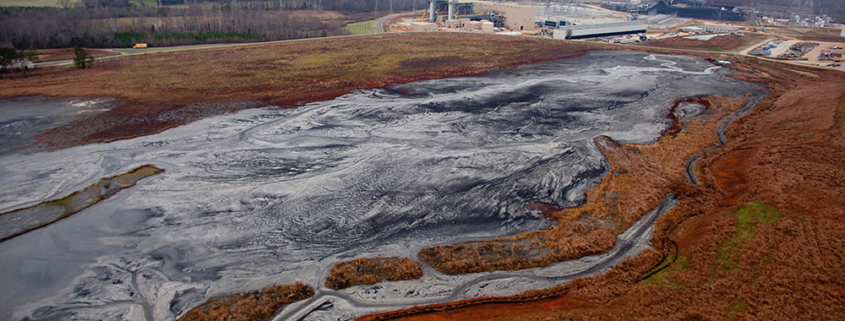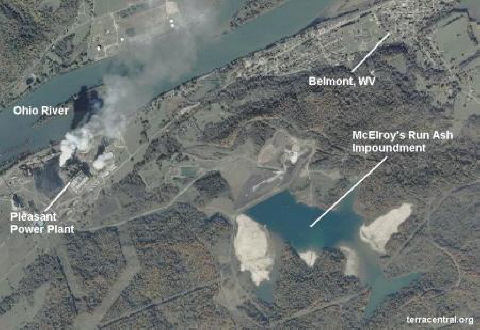Coal Ash: What Is It, Why It Matters, What You Can Do
The Buck Steam Station coal ash impoundment in North Carolina. Photo © Les Stone / Greenpeace
Coal ash. It’s the toxic by-product of coal-burning power plants and is an environmental issue West Virginia has been dealing with for decades. Four coal-burning plants in West Virginia have applied for extensions to keep using their unlined ash ponds beyond the deadline for all other plants, which was April 2021.
Read on to learn about what coal ash is, why it matters, and what you can do!
What is coal ash?
Coal ash, the toxic waste product that is left over after coal is burned, is one of the largest industrial waste streams generated in the United States – millions of tons are produced annually.
Historically, power facilities and utilities have disposed of coal ash by digging large holes and dumping in the coal ash. These disposal sites are referred to as coal ash landfills. Sometimes ash is mixed with nearby river water to make it easier for companies to transport the ash to a dump. This creates coal ash “ponds.” Both of these types of dumps are often tens if not hundreds of acres. Many of these sites are located in communities that are low-income and/or primarily people of color.
New regulations require unlined coal ash ponds to close. According to the industry’s own data, more than 95% of the coal ash ponds in the United States are unlined.
How does coal ash impact human health and the environment?
Coal ash is toxic to humans and animals. When coal ash comes into contact with water, it allows toxins to dissolve from the ash into the water which then leak into the environment. Toxins from coal ash include cadmium, lead, mercury and selenium. Surface waters like streams and rivers, as well as groundwater.
Almost all coal ash ponds are contaminating groundwater at levels higher than the EPA’s safe drinking water standards.
The EPA has also found that living next to a coal ash disposal site can increase the risk of cancer and other diseases. This is especially true of those who live near an unlined wet ash pond and drink from a well. The toxins found in coal ash are known to cause deformities in fish and health hazards to people consuming contaminated fish.
What are the rules protecting us from coal ash?
Before 2015, there were no federal laws protecting citizens from the dangers of coal ash. Under new regulations, utilities must now update their previously unlined ponds and landfills. Modern coal ash landfills and ponds must meet minimum safety measures, including the types of liners and capping systems that are used to keep the ash away from water and they must control and contain runoff. The regulations also include restrictions on where coal ash landfills and ponds can be located. Coal ash impoundments that do not meet current safety standards must be cleaned up.
Coal Ash in West Virginia
Seven plants in West Virginia are subject to the rules, 4 plants are seeking extensions to the deadline to close their ponds. They all have to monitor and report groundwater contamination.
These four facilities – the John Amos Power Plant in Winfield, the Mitchell Plant on the Ohio River in Moundsville, the Mountaineer Plant in Letart and the Pleasants Power Station at Willow Island – are required to monitor and report data on groundwater near their facilities. Groundwater contamination has been detected at all four plants.
How does coal ash effect environmental justice?
The EPA has found that some communities are impacted more than others by the negative health effects associated with coal ash. Communities of color and low-income communities are often located closer to power plants and bear more of the burden of pollution. These burdens increase the risk of disease and economic hardship. Allowing continued operation of unlined coal ash ponds and landfills is unjust.
What needs to happen to protect human and environmental health?
Policymakers, industry and communities must work together to keep the public safe from coal ash pollution. The safest solution is to hold all coal ash disposal sites accountable for meeting all regulatory requirements and deadlines.
We need to push back against regulatory exemptions and require coal burning utilities to adhere to modern practices. We need to put pressure on polluters and regulators to maintain groundwater monitoring networks that are designed to detect contamination. And when we find contamination, we need to demand prompt clean up.
What resources are available for community organizations to test water?
If you drink from a well and live near one of the four power stations asking for an exemption, (the John Amos Power Plant, the Mitchell Plant, the Mountaineer Plant and the Pleasants Power Station) it’s important to know what’s in your water.
The Mountain Watershed Association and WV Rivers both provide small grants to grassroots groups that advocate for environmental justice. These grants can be used to obtain funding for drinking water monitoring.
How can you become an advocate?
Participate in the federal regulatory process. Sign up for the EPA’s news alert system and be informed about opportunities to comment on proposed rules and rule changes.




